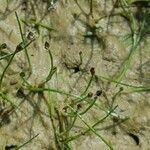Perennials, stoloniferous. Rhizomes often terminated by small fusiform tubers. Culms light green, tufted, 1-7 cm tall, capillary. Leaf sheaths 1(or 2), tubular, short, hyaline, inconspicuous, mouth oblique at orifice, apex obtuse. Spikelet light green, ovoid to ovoid-ellipsoid, 2-4 × 1-2 mm, subcompressed, 6-10-flowered. Basalmost glume empty, ca. 1/2 as long to as long as spikelet, amplexicaul for ca. 2/3 of spikelet base; fertile glume straw-colored to reddish tinged, ovate, 1.4-2.7 mm, membranous, apex subacute to rounded. Perianth bristles 4-6 or rarely absent, usually equaling nutlet to slightly exceeding tubercle, sometimes of different lengths, some ca. 1/2 as long as nutlet, minutely retrorsely spinulose. Stigmas 3. Nutlet straw-colored to pale brown, obovoid to obpyriform, 0.9-1.5 × 0.6-1 mm, 3-sided with plane to concave faces, smooth, apex not constricted; persistent style base triangular-subulate, 0.1-0.3 mm. Fl. and fr. Jul-Oct.
Tubers terminating rhizomes usually markedly J-or horseshoe-shaped, body (apart from apical bud) oblong, 2–2.5(–5) × 0.5–1 mm; tubers among culm bases straight, narrowly fusiform, 4–5 mm. Spikelets 2–4 × 1–2 mm, sometimes absent in deeper water; proximal scale 1/2 or more of spikelet length; floral scales 6–10 per spikelet, 1.4–2.7 mm, commonly entirely stramineous, apex rounded to subacute. Flowers: perianth bristles 6, stramineous, fairly stout to slender, usually equaling achene to slightly exceeding tubercle, sometimes unequal and some 1/2 of achene, very rarely rudimentary, minutely retrorsely spinulose; anthers 0.7–1.2 mm. Achenes stramineous, sometimes pale brown, obovoid to obpyriform, thickly trigonous, angles distinct, faces concave to plane, rarely convex, 0.9–1.2 × 0.55–0.75 mm, apex tapered, smooth or faintly rough at 30X. Tubercles 0.1–0.2 × 0.15 mm. 2n = 10 (Europe).

